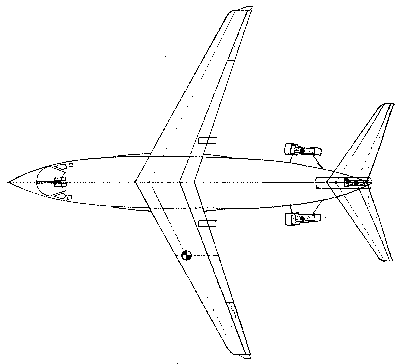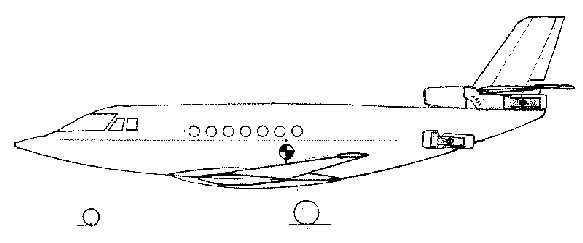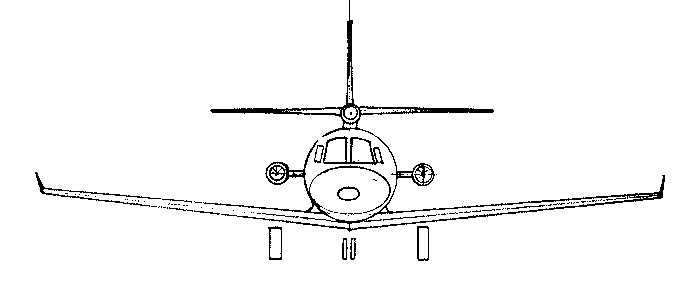





Mission Requirements:
Assumptions:
|
# |
Segment |
Description |
Values |
Fraction |
|
1 |
W1/Wo |
Engine Start Warm Up Taxi Take off |
.990
.990 .975 |
.9752 |
|
2 |
W2/W1 |
Climb |
.980 |
.980 |
|
3 |
W3/W2 |
Cruise |
R=2800 Nm C=.65 lb/lb/hr V=(.8 * 968) L/D cruise = .866(L/D)max |
.7533 |
|
4 |
W4/W3 |
Descent |
.990 |
.990 |
|
5 |
W5/W4 |
Loiter |
E=45 min C=.43 lb/lb/hr (L/D)max = 16.17 |
.9803 |
|
6 |
W6/W5 |
Land Rollout Taxi |
.992 |
.992 |
Initial Sizing of Jet Transport
|
Mission Weight Fraction (W6/Wo) |
.6931 |
|
Mission Fuel Fraction (1-W6/Wo) |
.3069 |
|
Total Fuel Fraction (1.01*(1-W6/Wo)) |
.3100 |
Empty Weight Fraction is given by where A is 1.02, C is -.06 and K is 1.0 as per the handout in class.
The total weight is given by where Wcrew is 400 lbs, Wpayload
is 5000 lbs, and WF/Wo is the total fuel fraction given on the
previous page as .3100.
|
Wo |
We/Wo |
New Wo |
|
50000 |
0.53292 |
34377.4 |
|
34377.4 |
0.54503 |
37250.2 |
|
37250.2 |
0.54242 |
36589.3 |
|
36589.3 |
0.543 |
36734.4 |
|
36734.4 |
0.54287 |
36702.2 |
|
36702.2 |
0.5429 |
36709.3 |
|
36709.3 |
0.54289 |
36707.8 |
|
36707.8 |
0.54289 |
36708.1 |
|
36708.1 |
0.54289 |
36708 |
|
36708 |
0.54289 |
36708.1 |
|
36708.1 |
0.54289 |
36708.1 |
After the iterations of Wo, the total weight of the aircraft is to be
36,708.1 lbs.
Verification:
|
WE |
19928.46 lbs. |
|
WF |
11379.51 lbs. |
|
Wcrew |
400 lbs. |
|
Wpayload |
5000 lbs |
|
Total Weight |
36707.96 lbs |
Estimation of T/W and W/S
The following values were used:
Dash:
|
(W/S)dash |
Term 1 |
Term2 |
(T/W)R |
(T/W)R-w |
(T/W)R-W |
(W/S)o |
|
50 |
0.08847 |
0.01106 |
0.09952 |
0.09512 |
0.52842 |
52.3179 |
|
60 |
0.07372 |
0.01327 |
0.08699 |
0.08314 |
0.46187 |
62.7815 |
|
70 |
0.06319 |
0.01548 |
0.07867 |
0.07518 |
0.41769 |
73.245 |
|
80 |
0.05529 |
0.01769 |
0.07298 |
0.06975 |
0.38749 |
83.7086 |
|
90 |
0.04915 |
0.0199 |
0.06905 |
0.06599 |
0.36661 |
94.1722 |
|
100 |
0.04423 |
0.02211 |
0.06635 |
0.06341 |
0.35226 |
104.636 |
|
110 |
0.04021 |
0.02432 |
0.06454 |
0.06168 |
0.34265 |
115.099 |
Maneuver:
|
(W/S)F |
Term 1 |
Term 2 |
(T/W)R |
(T/W)R-w |
(T/W)R-wl |
(W/S)o-w |
|
50 |
0.05512 |
0.17763 |
0.23275 |
0.22693 |
0.24667 |
51.2821 |
|
60 |
0.04593 |
0.21316 |
0.25909 |
0.25261 |
0.27458 |
61.5385 |
|
70 |
0.03937 |
0.24869 |
0.28806 |
0.28085 |
0.30528 |
71.7949 |
|
80 |
0.03445 |
0.28421 |
0.31866 |
0.31069 |
0.33771 |
82.0513 |
|
90 |
0.03062 |
0.31974 |
0.35036 |
0.3416 |
0.37131 |
92.3077 |
|
100 |
0.02756 |
0.35527 |
0.38282 |
0.37325 |
0.40571 |
102.564 |
|
110 |
0.02505 |
0.39079 |
0.41585 |
0.40545 |
0.44071 |
112.821 |
The design point was found to have the following values:
(T/W)o = .37
(W/S)o = 92.1 PSF
Taking the base line engine thrust of 4250 lbs. and scaling it up by
10% for an engine thrust of 4675 lbs. each, it will take 3 engines to power
the aircraft.
3 engines * (4675 lbs/engine) = 14025 lbs. This value is slightly higher than the actual need thrust, but engines do not always perform at maximum specification, so this leaves a safety margin.
Landing Data
SFL = .3*(VA)2 where SFL is given in the RFP as 5500 ft, thus (VA)2 = 18333.33
VA = 135.401 knots
VSL = VA/1.3 = 104.15 knots or 175.793 ft/sec.
but (WL/Wo) = .88 so
|
(Clmax)landing |
(W/S)o ~PSF |
|
2.0 |
83.51 |
|
2.2 |
91.86 |
|
2.4 |
100.21 |
Interpolating, this gives a maximum coefficient of lift when landing
of 2.21.
Take-off Data
STOFL = 5800 ft.
TOP25 = 5800/37.5 = 154.67lbs/ft2
|
(W/S)TO |
(T/W)TO |
|
||
|
CLmax=1.4 |
CLmax=1.6 |
CLmax=1.8 |
CLmax=2 |
|
|
60 |
0.27709 |
0.24245 |
0.21551 |
0.19396 |
|
70 |
0.32327 |
0.28286 |
0.25143 |
0.22629 |
|
80 |
0.36945 |
0.32327 |
0.28735 |
0.25862 |
|
90 |
0.41563 |
0.36368 |
0.32327 |
0.29094 |
|
100 |
0.46181 |
0.40409 |
0.35919 |
0.32327 |
From the design plot, CLmax in Take off = 1.6.
| Fuselage | ||
| Length | 61.5 ft. | |
| Diameter | 9 ft. | |
| Fineness Ratio | 6.8333 | |
| Main Wing | ||
| Area | 398.57 ft2 | |
| Aspect Ratio | 8.5382 | |
| Wing Span | 58.34 ft. | |
| Leading Edge Sweep | 28 | |
| Taper Ratio | .35 | |
| Root Chord | 10.12 ft. | |
| Tip Chord | 3.54 ft. | |
| Quarter Chord Sweep | 25.42 | |
| Mean Aerodynamic Chord | 7.36 ft. | |
| Spanwise Location MAC | 12.24 ft. | |
| Mean Geometric Chord | 6.83 ft. | |
| Thickness Ratio | .14 | |
| Wing Fuel Volume Avail. | 166.32 ft3 | |
| Fuel Volume Required | 232.23 ft3 | |
| Dihedral | 5 | |
| Weights | ||
| Design Take-off Weight | 36708.1 lbs. | |
| Design Empty Weight | 19928.46 lbs. | |
| Design Fuel Weight | 11379.51 lbs. | |
| Crew Weight | 400 lbs. | |
| Total Payload | 5000 lbs. | |
| Aerodynamic | ||
| Clean CDo | .0218 | |
| Cruise "e" | .85 | |
| Engine | ||
| Total S.L. Thrust | 13582 lbs. | |
| Thrust/Engine | 4527.3 lbs. | |
| Number of Engines | 3 | |
| Core Length | 49.2 in. | |
| Core Diameter | 19.82 in. | |
| Core Weight | 536.00 lbs. | |
| Empennage | ||
| VH | 1.0 | |
| SH | 117.34 ft2 | |
| LH | 25 ft. | |
| VV | .09 | |
| SV | 77.5 ft2 | |
| LV | 27 ft. |
Validation of Assumed CDo
The equation log10 Swet = c + dlog10
Wo can be used to find the wetted area. The constants c and d are found
in Roskam in Table 3.5 in Part 1, page 122.
c = .0199
d = .7531
The wetted area was found to be 2868.28 ft2.
The equation log10 f= a + blog10 Swet
can be used to find a value for the equivalent parasite area where the
constants a and b are found in Roskam part 1, page 122, Table 3.4.
Cf = .0030
a = -2.5229
b = 1.0000
The equivalent parasite area was found to be 8.60441 ft2.
Finally, the CDo can be found by dividing f by the wing area.
This gives:
CDo = .02158 ~ .0218